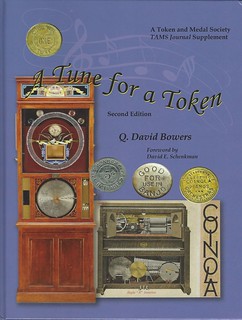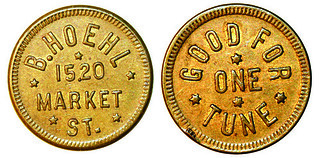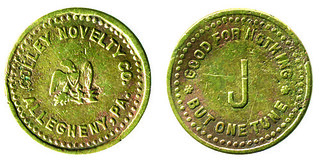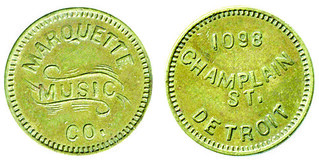
PREV ARTICLE
NEXT ARTICLE
FULL ISSUE
PREV FULL ISSUE
NEW BOOK: A TUNE FOR A TOKEN 2ND EDITIONRegarding a new TAMS Journal Supplement, Bill Hyder of the Token and Medal Society writes:
Owing to staffing shortages at our local post office and my desire to not be the cause of building up a line of others waiting for postal services, I am mailing one or two cases a day (14 to 28 books a day). If TAMS members are patient, their book will arrive sometime by the end of June. The good news for non-TAMS members, if you join in the next few months you will receive a copy of the book while supplies last." What a huge benefit for TAMS membership! See below for the link to their site. Here's an excerpt from the book's Introduction by Dave Bowers. -Editor Welcome to the second edition of A Tune for a Token. The first edition published by the Token and Medal Society won the Publication of the Year Award. The second builds on the first and adds many new things. The main reason for creating this book in 1975 and updating it now is because I like the thrill of the hunt, to explore the obscure and sometimes unknown. Few specialties are as obscure as these music tokens! I have taken a number of other numismatic byways in my life. My book, The Strange Career of Dr. Wilkins, about a dentist who in the 1850s and 1860s counterstamped hundreds of cents with his name as an advertisement, was fun to research and write and, believe it or not, was well received and sold out. Numismatists seem to like interesting stories. Wilkins was a character deluxe. He also had a restaurant and kept a caged bear in front. He was accused of counterfeiting and also burning down a barn of someone who had crossed his path. Along the same line my Waterford Water Cure book explored the counterstamped coins issued by Dr. Shattuck who operated a clinic or retreat in Waterford, Maine in the 19th century, when the water cure treatment was popular nationwide and was said to cure just about any malady known to mankind. That book also sold out, and John J. Ford, Jr. said it was his favorite of the books I have written over the years.
Tokens described in this book have many different inscriptions, some describing coin-operated pianos and orchestrions in various locations from The Bowery in New York City to out West in the Cliff House near the entrance to San Francisco Bay. I love the Cliff House and its traditions and have visited the site many times—the new Cliff House built in the early 20th century and the adjacent Sutro Baths amusement facility, not to overlook the nearby Playland at the Beach. From the Whitney family, owners in the 1960s of all three of these establishments, I purchased many coin-operated instruments that had been left over from the "good old days." In this book you will read about the Cliff House and a token once used there. To me if the history is known about a token, medal, coin, or bank note, my interest in it multiplies. Because of this, when the location of a token can be identified I try to learn about the establishment that issued it. In this book you will read about many such places. One token can lead to enough fascinating information that I could create an article on it for the Token and Medal Society Journal. In the past for the TAMS Journal, The Civil War Token Journal, The Numismatist, Coin World, and other periodicals I have written many articles on interesting varieties of tokens, medals, paper money, and other obscure subjects. David Schenkman, who consented to write the foreword to this book, has done the same over a long period of years. His contributions to the present text were immense and added much to the listings. He has dealt in various store cards and related tokens since 1960 and supplied most of the rarity and price estimates. A list of his articles on other types of tokens would fill several pages.
I also give a nod to Bill Hyder of the Token and Medal Society who shepherded my book on shell cards through to publication and will be doing the same with this. Among my new friends gained in recent research is Julia H. Casey, who more than any other contributor to the present book tracked down and in many instances furnished information about tokens that would otherwise be listed in appendix 2 (named tokens from unknown locations). John Byars has been a close second in research discoveries. Both have tracked down information that has eluded me for decades. And here's an excerpt from the book's Foreword by David Schenkman. -Editor In 1975 the Token and Medal Society published Dave Bowers' catalog, A Tune for a Token, and I remember being immediately fascinated by the many different tokens he listed. Dave didn't merely compile a catalog; he also discussed automatic musical instruments, and the tokens themselves. I immediately started collecting tune tokens! One of the things collectors new to the hobby learn early on is the fact that tokens are not easy to find. So, even if cost is not a consideration, building a collection takes time and persistence. Without exception, every one of the tokens cataloged herein is many times rarer than United States coins such as the 1916-D dime and 1877 Indian cent, and most of them are even rarer than the famous 1804 silver dollar. The corollary is that for the price of a Mint State 1916-D dime, of which many hundreds are known, with a lot of patience you can form one of the best tune tokens ever! In contrast, if you want a Mint State 1916-D dime you can buy one on the Internet this afternoon.
If you are just starting to read this book, you are in for a real treat. You'll soon learn that it is much more than just a catalog. Dave has a wonderful way of weaving history and numismatics, and you will find yourself as engrossed in the life and times of the late nineteenth and early twentieth centuries as I was when I read it. In the process you'll learn a lot about tokens and who knows; you just might find yourself as addicted to collecting tune tokens as I was after reading Dave's 1975 study. For more information on the Token and Medal Society, see:
 Wayne Homren, Editor The Numismatic Bibliomania Society is a non-profit organization promoting numismatic literature. See our web site at coinbooks.org. To submit items for publication in The E-Sylum, write to the Editor at this address: whomren@gmail.com To subscribe go to: https://my.binhost.com/lists/listinfo/esylum All Rights Reserved. NBS Home Page Contact the NBS webmaster 
|



